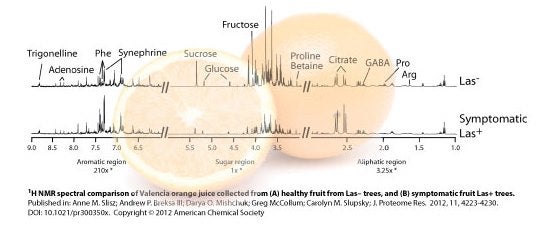Metabolomics of food is increasingly becoming an important area of research. With food being the major vehicle that affects the gut microbiome and overall health, it is important to understand the components of food, and how these components are altered by food processing as well as agricultural techniques.
Food has previously been evaluated based on protein, carbohydrate, moisture, lipid and ash content. However, only now it is possible for us to perform a detailed examination of the chemical composition of food. Metabolomics can distinguish where a food is from, and whether fertilizers or pesticides were used (See our study in J Ag Food Chem and Food Chem).
In the case of pathogens that are destroying crops, metabolomics can determine which trees are affected, and help to find ways to combat disease. Our focus in this area is to understand how Huanglongbing (HLB) disease affects citrus metabolism and determine biomarkers for the disease. HLB is caused by the citrus pathogen Candidatus Liberibacter asiaticus (CLas) which is spread by in insect known as the Asian citrus psyllid (ACP). Our research study on HLB disease will be most relevant to consumers, growers and the food industry and allow for developing better disease prevention and management strategies (see our work in J Proteome Res).
Metabolomics will also be important for generating food that mimics other food. For example, metabolomics of human milk has shown several small molecule components that we believe are important for infant health (see our work in J Nutr). These studies will help with the formulation of the next generation formulas for women who are unable to breast feed.
Chemical aspects of food can also be linked with sensory analysis to more fully understand how the components of food come together to create unique taste profiles (see our work in Food Chem).

